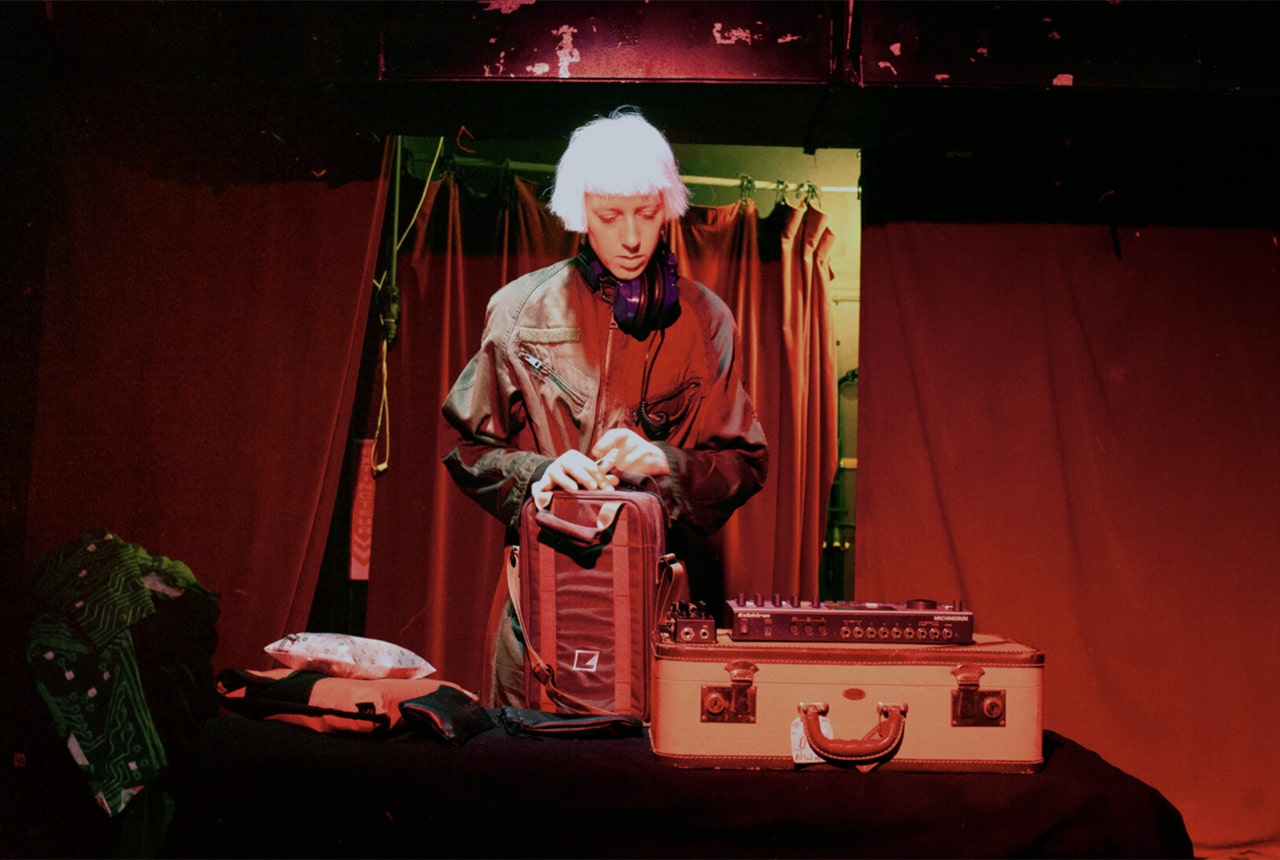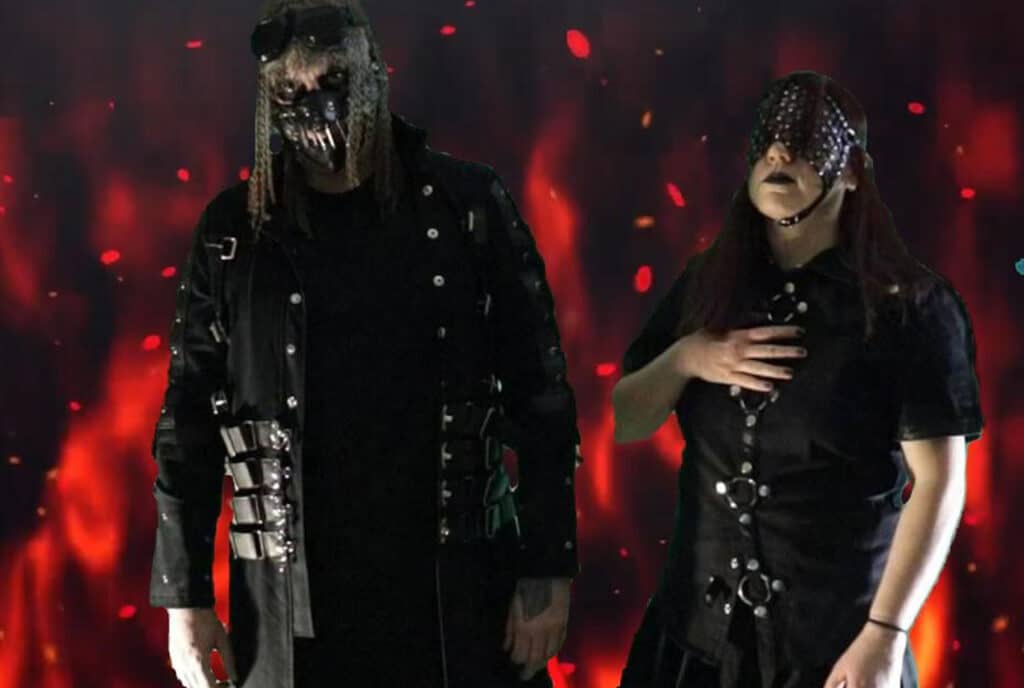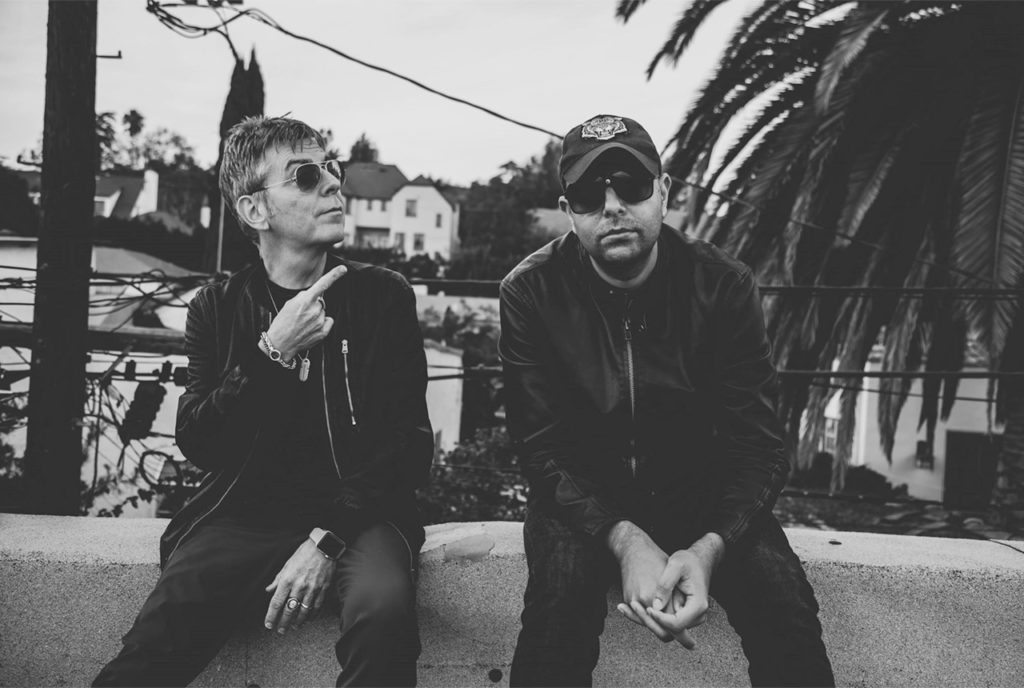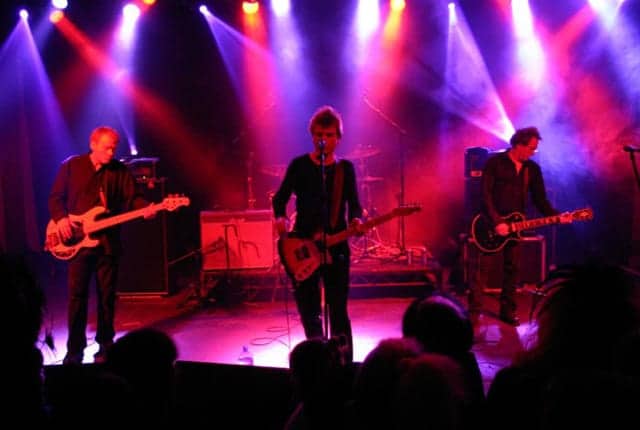With her solo electronic project Rare DM, Erin Hoagg leans towards the sounds of vintage analog synths but uses them in a thoroughly modern way. The Brooklyn-based singer/producer/multi-instrumentalist has worked hard to tame the gear into a workflow suited to her creative process and musical background. The result is a dark, moody sound with intricate arrangements that take unexpected paths. Rare DM is known for putting on strong live shows where Hoagg’s choice of electronic equipment allows her to put on very hands-on and dynamic performances. The debut Rare DM album, Vanta Black, came out in 2019 and a string of new singles has followed it. The most recent is “Naomi” (2022). Rare DM has performed at many high-profile events, and this fall will appear at Cold Waves X (Chicago).
Could you talk about the evolution of your sound from the album to the more recent singles? From what I’ve read, upgrading your equipment has made a difference, but I’m wondering if you could be a bit more specific about how your process may have changed.
When I recorded my album, my set-up was more limited. I had a Scarlet, which is an interface with, I think, two inputs. I could do MIDI on there too, but I would usually just record like a [Elektron] Machinedrum drum track and then, like, play Juno 60 on top of that and cut that up and then do more layers of Juno 60 or more layers of drums. But with the limitations, it also meant that I couldn’t really separate drum sounds onto different channels. And basically, I upgraded to having an Apollo 8p interface, which has eight inputs. And during that time, whenever I’d get extra money of any kind, I’d want to buy new gear; I’m super into Craigslist. I was buying like … I have a 707. I got if for $275 instead of like $550, which is really great, things like that. So, I started MIDI syncing a bunch of different drum machines. I have a Beat Step Pro that is triggering my Juno 60 so that the arpeggiator is always in sync. I have the same thing sending a clock into my 707 and my Machinedrum, and my SDS9 is being triggered by my Beat Step Pro as well so I can sequence cool drum sounds. Even more recently, I got an Audient eight-channel microphone preamp that you can use to record audio. So now I have 16 channels, which gets even more intense, and it’s just really fun because since I’m a one-man band, I like to be able to jam with myself. So I’ll set up some cool drum sound and then go, like, jam on my arpeggiator on the Juno 60 while I jam with the Casio CZ-5000 as a lead. It’s just way more of a natural workflow for me. Whereas like before, I would have to be like, okay, start, stop, start, stop. You don’t have, like, organic flow if you only have two channels. And I don’t make software sounds, really. To me, working on a computer doesn’t feel that intuitive. It’s nice when it feels like a drum set, because that was my first instrument. So you can, like, play the cymbal over here, kick over here.
In terms of those initial limitations, do you feel that anything positive came out of that? Did that experience with limitations kind of shape where you are today in any way?
Well, if anything, it kind of showed me what I’m not trying to do anymore. Because I kind of refer to my debut album as being a little bit more like emotional vomit, on the fact that it was largely improvised takes that I would just kind of, like, be like, “All right! Where’s the next one?” And the guy that mixed my debut album; we’d listen to some of the songs I’d have, and he’d be like, “That’s a song. Next one, move on”. I was pushed to have a full album out in a way that I wouldn’t want to do again, because it was more about having a full thing done as opposed to having individual tracks that I was really proud of.
“Almost A Year” was the first one that was mixed on the album, and it shows. That song is actually like generally the way that I want it to be. Although I think my singing is super improved since then. So a lot of the time when I listen to these older songs, I end up being like, “Oh God”. But I do like how honest it is. So that’s like a very emotional album, and all of those songs are very urgent emotionally.
I’m curious about your musical background. Have you always been primarily interested in electronic music? Did you have any previous musical experience before doing this style?
My first instrument was a drum set and percussion. My dad is a drummer, and I think he really wanted an excuse to have a drum set in the basement. So when I was 11, there was a drum set that came into existence for Christmas. He picked out all the cymbals he wanted. So he got all excited about it, but I was taking drum set and percussion lessons. My drum teacher insisted on me having mallet percussion lessons, too, like marimba and xylophone, vibraphone, et cetera. Basically, with that I learned how to read music, and I was in a band and then I did jazz band and drum line.
When I moved to New York City, for fashion design school, I started going to shows and meeting people, and people would find out that I played drums. And I had a few different bands that I was in briefly. I was starting the bachelor’s in accessories design program and not liking it as much as I liked the associate’s [degree] in fashion design that I got. It’s just a different process, which actually is funny, because I think about it a lot. Fashion design is like ‘here, let me work on a sculpture and tweak it until I like it. Whereas accessories design is ‘you must have a plan.’ Otherwise, it won’t function, like you have to cut the leather out to make the bag right the first time. Whereas, when you’re draping something, you can pin it and adjust it and pin it again. So that kind of goes into my process. I don’t go into a song knowing exactly what I want to do. I’m gonna pin it and adjust it. So I kind of realized I wasn’t really liking accessories design, and I wasn’t doing the best I could possibly do in the band that I was in at the time. I just ended up getting more and more into it and then quitting the band I was in to do my own solo project.
As for, if I was always into electronic music, I actually recently got this book on Bloghouse. I love Bloghouse music, and it’s been really fun because I’m reading it. And I’m like, ‘holy shit.’ Like, I knew these were Bloghouse bands, but I’m realizing that all of my favorite music to listen to in high school was Bloghouse. I didn’t really realize… I had an apartment for three months with this lady who had a MicroKORG, and that was like my first experience with playing around with songs that I’d written on piano. There was a grand piano in the teacher’s lounge at FIT where I went to school, and I would sneak up there constantly between classes and play on the grand piano. And I started writing songs just on piano. And then when I started playing around with … I don’t know if you want to call her a roommate or a landlord, whatever, because it was her apartment. And she picked how much the rent was. [With] the MicroKORG it was just like, “Oh, wow. I can finally, like, hear these songs the way that I’d want to listen to them”. Because I’m not over here listening to piano music, I’m listening to, like, you know, Ladytron or The Knife. They’re not using a grand piano. They’re using synths.
And so, like, suddenly I was able to be like, “Holy shit, I could make my music kind of sound the way I wanted to, can’t I?” So that just put into context something that hadn’t really clicked before, which was electronic [music]. Because I’d played around the Garage Band in high school, and obviously it had some synth sounds on there. But it wasn’t intuitive, again, because I wasn’t hitting something. So basically, I finally had something to hit, and I realized I wanted more things to hit. And so I started getting drum machines and playing around with them and synthesizers and stuff. And then I was finally making the music I would actually want to listen to.
In terms of assembling all the gear, was it obvious what you wanted? Did you have sounds in mind and then research what equipment you needed?
That’s a great question. First of all, I really kind of sought out things that looked like they would retain their value. I’ve always been into vintage items and antiques, so originally I would kind of look for weird pieces of gear. The Juno 60 was a very conscious choice. I searched for that for a while, but like my Machinedrum, which was one of my first pieces of gear, I got it for like $700, which is pretty cool because now they’re going for like $2,500 sometimes. But basically, I was just like, ‘This looks like a really cool drum machine, and I haven’t seen that many of these. Here we go, I’ll give it a go.’ But some of the other pieces of gear that I have, like my [Simmons] SDS-9 and SDS-1 … I hadn’t really heard people talking about Simmons drums that much. I didn’t know, then, that one of my favorite bands, Front 242, uses a Simmons. I think they have an SDS-8, which has the same sort of sound. But basically, I would just kind of want something that wasn’t new. I didn’t want to have some like a shiny new TR-09 or something, even though I actually did very briefly have a TR-09 that I ended up selling. I tried the new gear. I didn’t like it. It’s because I like things that have dust and character. So I would kind of seek out things that I thought might retain their value, that I thought seemed a little bit stranger, so the sounds would be more unique. I like it when they look fun and cool. Everybody has a MicroKORG, and I did get a MicroKORG originally because it was the first synth I’d heard of. And it was cheaper, but I’m not trying to go and buy the MicroBrute or Minilogue, because everybody has one right now.
So how does this impact your approach to live performance? Are there any challenges to adapting the music to a set-up you can bring on stage and on tour?
When I first started playing live, I had the classic SP404 SX. I just was determined not to have a computer on stage with me, so that’s always been a goal. I thought, you know, who are the big electronic artists, when I started out, that you might look to that weren’t a band, Oh, Grimes, John Maus. Oh, they both used an SP404 SX. So I was like, all right, here we go. SP404. But I was so annoyed by it because it was very limited. I was kind of just really frustrated from the get-go. Because with the songs, there just wasn’t that much you could do. You could try to, like, go and break them up a little bit into these loops or something, but it just didn’t seem right. And so, when I was looking into it, the Octatrack seemed to be the one that would have longer form samples that I could, like, change the time signatures to and have it so that I could slow it down or speed it up and have a drum machine stay in sync. So it was just kind of natural … So, I got an Octatrack, and it was the older version. And I got it off of Craigslist, and it had some issues. And I just could not figure out why I couldn’t get this thing to work.
And it was really frustrating. I found out it was a sticky button thing, with the function button, which is REALLY important, obviously. It was getting stuck and making it so that I couldn’t trigger my samples correctly. Or it was like always keeping a sound on, just really frustrating. So it just kind of sat around for a while. And then I got a Machinedrum and learned the Electron workflow. And I was like, “Wow, wait, this is like way more fun. Like I’m actually really like enjoying jamming with this thing”. And then I went to buy the SDS-9 that I found on Craigslist, from this guy in Chinatown’s house. And I walk in, and his studio has three SH101s, an 808 and a 909, the real deal.
Just, like, every cool …. He had an STS-8 and an SDS-9, and he was selling the SDS-9. He had everything synced up, you know, and it was just like this really cool moment. And I really hit it off with him. And he was like, “Yeah, you know, sometimes I teach lessons”, blah, blah, blah. And I was kind of like, “Oh really? Like, you teach, like, production lessons?” And it was just kind of this cool moment that …. His name’s Ray Rose. I ended up being, like, “Alright, that’s not that expensive. I could do that every once in a while”. He had an Octatrack, and I was like, “You could teach me how to use this thing?”
But he had the newer version, and the workflow was so much easier on the newer version, partly because it wasn’t broken. I was like, “Wait, this is actually the perfect piece of gear for my live set-up”. So I sold my old one. I saved up. I bought a new Octatrack, and that ended up just being like the perfect piece of live gear, because then it’s natural to me as somebody who plays drums, to want to jam on a Machinedrum. So it can be MIDI synced with my longer form samples on the Octatrack. And I came up with a way that I really enjoy doing my live set-up, that feels natural. I needed my hand held a little bit on the Octatrack, I guess, because there were just things that I just was not computing, like the fact that your samples need to be 16-bit. I would put in a sample, and it would sound completely wrong. And I’d be like, “Why did this happen?”
And then he’d just be like, “Oh, it’s 24 bit. It got pitched down because your sample wasn’t, like, in the right bit rate”. Yeah, maybe I could have Googled it enough until I found out the problem, but it’s really nice. For me, I just really love working with somebody. I don’t need to like claim that I’m like some whiz that, like, goes on YouTube and watches hundreds of hours of YouTube tutorials. I’d rather just ask a friend <laugh> what bit rate is the sample supposed to be? That was really nice. He moved, unfortunately.
Are you thinking all about live performance as you’re composing? Or do you worry about that after the track is done?
Usually, I finish the track and then worry about the live aspect. Some of the songs I have such a specific mix on them that I’m more hands-off of intervening with it live. There are a few songs that I play live that I focus more on the vocal performance as opposed to jamming on the Machinedrum. Whereas there are other songs that are very specifically jam-based. But there are times that I’ll be jamming and I’ll be like, that’s a cool loop. Do I wanna make that into a song? Maybe not, but do I want to get that 16-measure loop as a transition between this song and this song? Absolutely. So I’ll bounce out a little sample and then I’ll have another thing to jam with. And that’s a really great way to like deal with scraps and sketches. You don’t want it to go to waste, but you don’t want to make a whole song out of it.
You’ve been putting out a series of singles. Are these leading up to an album? Do you see these as one-offs? What’s the status of new material?
So I have probably five or six songs that are mixed or mastered at this point. Then like 10 demos that are pretty finished songs, but they aren’t mixed yet. And then, countless jams and I have to say, I’m getting a little sick of not having any label support. Yes, I love these. And I’m so proud of these big, beautiful videos that I have for “Send Nudes” and “Rolex”, but it’s a lot of time and a lot of my personal money. It’s kind of unsustainable. I cannot do three “Rolex” a year, and I would LIKE to be doing three “Rolex” a year. But on my own dollar, that’s something I don’t feel good about.
Right now it’s a track record of “Send Nudes” is 2020, “Rolex” is 2021. “Naomi” doesn’t have a video, but that’s 2022 right now. With “Naomi”, I was like, I need to actually put out a song. Like I need to stop putting so much pressure on myself to have a perfect video for every track. People do want new music from me and I want to have a better representation of the type of music that I make. As for is it leading up to something, I do want a video for the next single and I’m hoping that maybe through some of these bigger shows that I have coming up or maybe something that comes from the bigger shows that I just played. Maybe I meet the right person and have somebody that actually wants to work with me on a label front or something or, in the very least, a different distributor would be cool. Somebody that’s a little more hands-on, because it’s like screaming into a void right now. It’s just really frustrating to not reach ears because of not having a direct playlist connection at Spotify or whatever. And you can try to go viral on TikTok or viral on YouTube with your video, but it doesn’t really make the same dent as somebody that has a dude.
Speaking of TikTok, I’m wondering, does direct online interaction with the audiences affect you at all as an artist?
If anything, it just feels a little less lonely. It’s just encouraging that people care. Something that I don’t want to do is make music for TikTok. That has never been a goal. That’s not what I’m doing now. You know, when you can hear a song that has a little ding in it, like, oh, here’s this part like “da, da, da, da, da, da … DA”, you’re like, you know it’s for a TikTok dance. They’re trying to push this very specific type of thing. I never want to make music like that. But it is encouraging and nice when you’re able to be excited about a jam and then you post it and people are like, “Whoa, what did you use? What’s that drum sound?” The interaction feels encouraging, and it feels supportive.
For more info, visit raredm.com.










